Chhetri
Chhetri (Kshetri, Kshettri, Kshetry or Chhettri), (Nepali: क्षेत्री; IPA: [kʂet̪ri], or [tsʰet̪ri]; IAST: Kṣetrī) historically called Kshettriya or Kshetriya or Khas are Nepali speakers of Khas community some of whom trace their origin to migration from medieval India.[4][5] Chhetri was a caste of administrators, governor and military elites in medieval Khas Kingdom and Gorkha Kingdom (later unified Kingdom of Nepal).[6] The nobility of Gorkha Kingdom were mainly based from Chhetri families and they had a strong presence in civil administration affairs.[7] The bulk of Prime Ministers of Nepal before democratization of Nepal belonged to this caste as a result of old Gorkhali aristocracy. Gorkha-based aristocratic Chhetri families were Pande dynasty, Basnyat dynasty, Thapa dynasty and Kunwars (Rana dynasty & other Kunwars).
क्षेत्री/खस | |
|---|---|
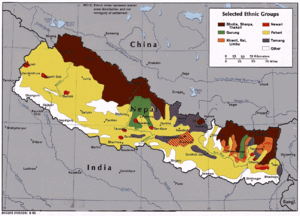 | |
| Regions with significant populations | |
| 4,398,053 (16.6% of Nepal; 2011)[1] | |
| Languages | |
| Nepali (Khas-Kura) as mother tongue[2] | |
| Religion | |
| Almost all are Hindu[3] | |
| Related ethnic groups | |
| Bahun, Thakuri, Dogra, Kumaoni, Magar, Other Indo-Aryan peoples | |
Khas Chhetris were traditionally considered a division of the Khas people with Khas Brahmin (commonly called Khas Bahun).[8] They make up 16.6% of Nepal's population according to the 2011 Nepal census, making them the most populous caste or ethnic community in Nepal.[1] Chhetris speak an Indo-Aryan Nepali language (Khas-Kura) as mother tongue.[2][4]
Etymology & Background
Chhetri is considered a direct derivative of the Sanskrit word Kshatriya.[9][10] According to the 1854 Legal Code (Muluki Ain) of Nepal, Chhetris are the social group among the sacred thread bearers (Tagadhari) and twice-born people of the Hindu tradition.[11][12] Almost all Chhetris are Hindu.[3]
History
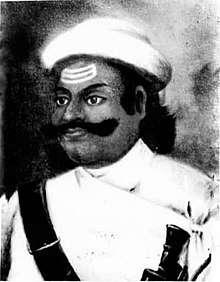
They are thought to be connected to the Khasas mentioned in the ancient Indian literature and the medieval Khasa kingdom.[13]
In the early modern history of Nepal, Chhetris played a key role in the Unification of Nepal, providing the core of the Gorkhali army of the mid-18th century.[14] Bir Bhadra Thapa was a Thapa of Chhetri group[15] and leading Bharadar during Unification of Nepal.[16] His grandson Bhimsen Thapa became Mukhtiyar (Prime Minister) of Nepal.[16] Swarup Singh Karki, a leading politician and military officer, belonged to Chhetri family.[17] Abhiman Singh Basnyat of Basnyat dynasty and Damodar Pande of Pande dynasty were both members of Chhetri caste.[18] Jung Bahadur Rana, founder of Rana dynasty also belonged to the Chhetri community.[19]
.jpg)
During the monarchy, Chhetris continued to dominate the ranks of the Nepalese government, Nepalese Army, Nepalese Police and administration.[14]
Chhetri noble families
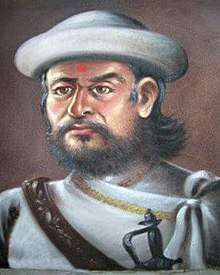
The most prominent feature of Nepalese Chhetri society has been the ruling Shah dynasty (1768–2008)[note 1], the Rana Prime Ministers (1846–1953), Pande family, Thapa family, Basnyat family,.[7] that marginalized the monarchy, and the Chhetri presence in the armed forces, police, and Government of Nepal. In traditional and administrative professions, Chhetris were given favorable treatment by the royal government.[21][22]
Chhetri and premiership
The nobility of Gorkha were mainly from Chhetri families and they had a strong presence in civil administration affairs.[7] All of the Prime Minister of Nepal between 1768 and 1950 were Chhetris with the exception of Ranga Nath Poudyal, being a Brahmin.[23] These number varied after the democratization of Nepal. Between 1951 and 1997, out of the 16 Prime Ministers of Nepal, 5 of them were Chhetris.[24]
Military achievements
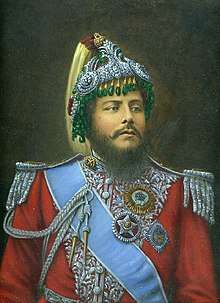
Chhetri had dominated high military positions and monopolized the military force at the times of Chhetri autocratic administrators like PM Bhimsen Thapa and PM Jung Bahadur Rana. There were 12 Basnyats, 16 Pandes, 6 Thapas and 3 Kunwar officers totalling to 51 Chhetri officers in the year 1841 A.D.[19] The most prominent officers at Shah administration were the Kazis which had control over civil and military functions like a Minister and Military officer combined. Rana Jang Pande, the leader of Pande faction, was the Prime Minister of Nepal in 1841 A.D.[25] which might have caused large Pande officers at 1841. After the rise Rana dynasty(Kunwars), the number changed to 10 Basnyats, 1 Pandes, 3 Thapas and 26 Kunwar officers totaling to 61 Chhetri officers in the year 1854 A.D.[19]
Chhetris dominated the position of the senior officers of the Nepali Army comprising 74.4% of total senior officers in 1967. Similarly, Chhetris composed of 38.1%, 54.3% and 55.3% of the senior officers in the year 2003, 2004 and 2007 respectively.[26]
Clans & surnames
Clans of the Chhetri include:[27]
Demographics
The 2011 Nepal census recorded Chhetris as the largest Hindu adherents in the nation with 43,65,113 people which is 99.3% of total Chhetri population.[1] Those Chhetri who follow Hinduism may also follow Buddhism. The ancient religion of the Chhetri is Masto which uses nature worship and can still be seen in western Nepal's Karnali district and in India's Gorkhaland. In Nepal's hill districts the Chhetri population rises to 41% compared to 31% Brahmin and 27% other castes. This greatly exceeds the Kshatriya portion in most regions with predominantly Hindu populations.[28][29]
Chhetris are largest caste group in 21 districts of Nepal as per 2001 Nepal census and 24 districts as per 2011 Nepal census. These twenty four districts are - Dhankuta district, Sankhuwasabha district, Okhaldhunga district, Udayapur district, Ramechhap district, Dolakha District, Salyan district, Surkhet district, Dailekh district, Jajarkot district, Dolpa district, Jumla district, Mugu district, Humla district, Bajura district, Bajhang district, Achham district, Doti district, Kailali district, Dadeldhura district, Baitadi district, Darchula district, Kalikot district and Kanchanpur district.[1] Among them, the district with largest Chhetri population is Kathmandu district with 347,754 (i.e. 19.9% of the total district population).[1] The literacy rate among Chhetris is 72.3% as per 2011 Nepal census.[1]
As per the Public Service Commission of Nepal, Brahmins (33.3%) and Chhetris (20.01%) were two largest caste group to obtain governmental jobs in the fiscal year 2017-18 even though 45% governmental seats are reserved for women, Madhesis, lower caste and tribes, people with disability and those from the backward regions.[30]
Present day
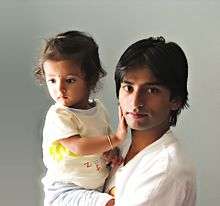
Chhetri together with Bahun and thakuri falls under Khas Arya, who are denied quota and reservations in civil services and other sectors due to their history of socio-political dominance in Nepal.[31] There are no quotas for the Khas community who fall under Bahun-Chhetri-thakuri hierarchy.[32] As per the explanation of legal provisions of Constitution of Nepal, Khas Arya comprises the Brahmin, Kshetri, Thakur and Sanyasi (Dashnami) communities.[33] But they are allowed reservation in federal parliament and provincial legislature.[34] The European Union has been accused of direct interference, creating ethnic strife and negative discrimination towards Khas Arya due to their recommendation to remove the reservation for Khas Aryas.[35][34]
Notable people
- Bir Bhadra Thapa[15] and Thapa dynasty[7]
- Swarup Singh Karki[17]
- Abhiman Singh Basnyat[18] and Basnyat dynasty[7]
- Damodar Pande[18] and Pande dynasty[7]
- Jung Bahadur Rana [19] and Rana dynasty[7]
- Amar Singh Thapa (sanu)[15]
- Queen Subarna Prabha Devi[36]
- Bhimsen Thapa[15][19]
- Gagan Singh Bhandari[37]
- Mohan Shamsher Jang Bahadur Rana[38]
- Sher Bahadur Thapa[39]
- Kunwar Inderjit Singh[40]
- Subarna Shamsher Rana[40]
- Surya Bahadur Thapa[40]
See also
References
Notes
- "Nepal Census 2011" (PDF). Archived from the original (PDF) on 2017-09-18. Retrieved 2017-04-09.
- Dhungel 1998, p. 5.
- Dhungel 1998, p. 8.
- Lawoti 2005, p. 91.
- Bista, Dor Bahadur (1980). People of Nepal (4 ed.). Ratna Pustak Bhandar. pp. 2–4.
- Pradhan 2012, pp. 20-21.
- Pahari 1995, p. 632.
- Hitchcock 1978, pp. 116-119.
- Burghart 1984, p. 119.
- Gurung 1996, p. 33.
- Sherchan 2001, p. 14.
- Gurung, H. (2005). Social exclusion and Maoist insurgency. Paper presented at National Dialogue Conference on ILO Convention 169 on Indigenous and Tribal Peoples, Kathmandu, 19–20 January 2005.
- Kumar Pradhan (1984). A History of Nepali Literature. Sahitya Akademi. p. 5.
- Gurung, Harka B. (1996). Faces of Nepal. Himal Books. pp. 1–33, passim.
- Regmi 1995, p. 44.
- Pradhan 2012, p. 22.
- Singh 1997, p. 142.
- Regmi 1975, p. 73.
- Adhikari 2015, p. 120.
- Pahari 1995, p. 631.
- Burbank, Jon (2002). Nepal. Cultures of the World (2 ed.). Marshall Cavendish. ISBN 0-7614-1476-2.
- Bajracharya, Bhadra Ratha; Sharma, Shri Ram; Bakshi, Shiri Ram (1993). Cultural History of Nepal. Anmol Publications. pp. 286–8. ISBN 81-7041-840-2.
- Raj 1996, p. 5.
- Gurung 1998, p. 129.
- Joshi & Rose 1966, p. 27.
- Adhikari 2015, p. 123.
- Subba, Tanka Bahadur (1989). Dynamics of a hill society: Nepalis in Darjeeling and Sikkim Himalayas. Mittal Publications. ISBN 9788173041143.
Some of the Chhetri clans are Adhikari, Baniya, Basnet, Bist, Bohra, Bura or Burathoki, Gharti, Karki, Khadka, Khatri, Khulal, Mahat, Raut, Rana, Roka, Thapa, etc.
- Dahal, Dilli Ram (2002-12-30). "Chapter 3. Social composition of the Population: Caste/Ethnicity and Religion in Nepal" (PDF). Government of Nepal, Central Bureau of Statistics. Archived from the original (PDF) on 2011-05-19. Retrieved 2011-04-02.
- "Nepal in Figures 2008" (PDF). Government of Nepal, Central Bureau of Statistics. 2008. Archived from the original (PDF) on 2011-07-23. Retrieved 2011-04-03.
- http://kathmandupost.ekantipur.com/news/2018-10-16/brahmins-and-chhetris-land-most-government-jobs.html
- "Khas Arya quota provision in civil services opposed". thehimalayantimes.com. 10 November 2017. Retrieved 1 May 2018.
- Aryal, Trailokya Raj (24 May 2017). "The Bahun narrative". Myrepublica. Retrieved 25 January 2018.
- "Nepal-India Relations: Need for Urgent Paradigm Shift - Mainstream Weekly". www.mainstreamweekly.net. Retrieved 8 June 2018.
- "Next Door Nepal: The nationalist's hour". indianexpress.com. 26 March 2018. Retrieved 8 June 2018.
- Rai, Om Astha. "Hail to the chiefs". www.nepalitimes.com. Retrieved 8 June 2018.
- Pradhan 2012, p. 12.
- Shaha 1990, p. 201.
- Yadav, P. (2016). Social Transformation in Post-conflict Nepal: A Gender Perspective. Taylor & Francis. p. 39. ISBN 9781317353904.
- Choudhuri, Poynder & Stevens 1984, p. 147.
- Institute of Constitutional and Parliamentary Studies (1980), Journal of Constitutional and Parliamentary Studies, 14, Institute of Constitutional and Parliamentary Studies
Sources
- Adhikari, Indra (2015), Military and Democracy in Nepal, Routledge, ISBN 9781317589068
- Burghart, Richard (1984), "The Formation of the Concept of Nation-State in Nepal", The Journal of Asian Studies, 44 (1): 101–125, doi:10.2307/2056748, JSTOR 2056748
- Choudhuri, P.; Poynder, F. S.; Stevens, Lt. Col. (1984), 9 Gurkha Rifles: a regimental history, 1817-1947, 4, Vision Books
- Dhungel, Dwarika Nath (1998), Contemporary Nepal, Vikas
- Gurung, Harka B. (1998), Nepal: Social Demography and Expressions, New Era
- Hitchcock, John T. (1978), "An Additional Perspective on the Nepali Caste System", in Fisher, James F. (ed.), Himalayan Anthropology: The Indo-Tibetan Interface, Walter de Gruyter, ISBN 978-90-279-7700-7
- Joshi, Bhuwan Lal; Rose, Leo E. (1966), Democratic Innovations in Nepal: A Case Study of Political Acculturation, University of California Press, p. 551
- Gurung, Harka B. (1996). Faces of Nepal. Himal Books.
- Lawoti, Mahendra (2005), Towards A Democratic Nepal: Inclusive Political Institutions for a Multicultural Society, SAGE publications India
- Pahari, Anup (1995), The Origins, Growth and Dissolution of Feudalism in Nepal: A Contribution to the Debate on Feudalism in Non-European Societies, 4, University of Wisconsin--Madison
- Pradhan, Kumar L. (2012), Thapa Politics in Nepal: With Special Reference to Bhim Sen Thapa, 1806–1839, New Delhi: Concept Publishing Company, p. 278, ISBN 9788180698132
- Raj, Prakash A. (1996), Brahmins of Nepal, Nabeen Publications
- Regmi, Mahesh Chandra (1995), Kings and political leaders of the Gorkhali Empire, 1768-1814, Orient Longman, ISBN 9788125005117
- Regmi, Mahesh Chandra (1975), Regmi Research Series, 7, Regmi Research Centre
- Shaha, Rishikesh (1990), 1769-1885, Manohar, ISBN 9788185425030
- Singh, Nagendra Kr (1997). Nepal: Refugee to Ruler: A Militant Race of Nepal. APH Publishing. p. 142. ISBN 9788170248477.
- Sherchan, Sanjaya (2001), Democracy, pluralism and change: an inquiry in the Nepalese context, Chhye Pahuppe
Further reading
- Debra Skinner; et al. (1998). Selves in time and place: Identities, Experience and History in Nepal. Roman & Littlefield Publishers. ISBN 978-1-46171-142-1.
- Lall, Keshar (1987). Nepalese Language, Folklore and Practices for Foreigners. Himalayan Book Centre.
- Jain, Danesh; Cardona, George (2007). Indo-Aryan languages. Routledge. ISBN 9781135797119.
- Negi, S. S. (2002). Discovering the Himalaya. Indus Publishing House. ISBN 978-8-17387-079-8.